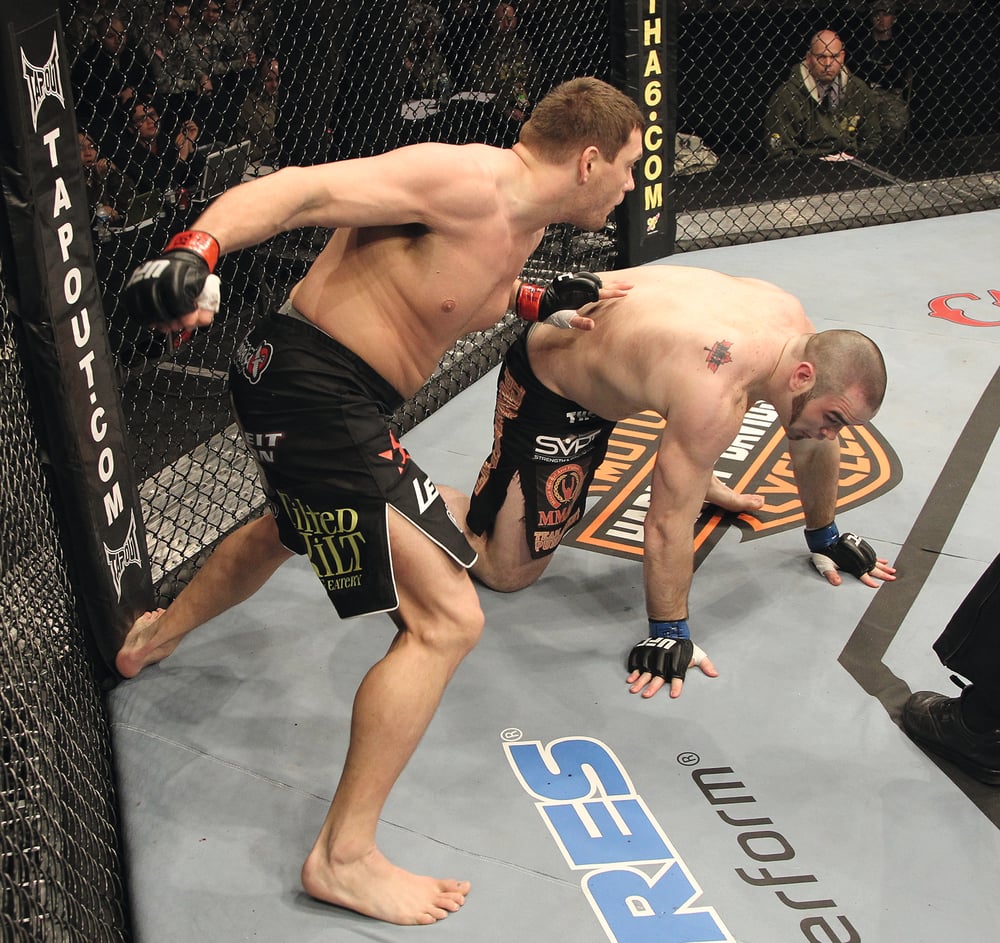
Issue 075
May 2011
Each issue UFC referee Marc Goddard brings fight fans the ref’s side of the story
THIS MONTH
What constitutes a ‘downed opponent’? Is it ‘cheating’ to put a knee or hand to the ground to become ‘downed’ in the eyes of the rules? And why is a knee to the head of a downed opponent so much more dangerous than if they’re standing up?
So, what’s the definition of a ‘grounded’ fighter? It’s a common enquiry and the answer is fairly simple: but application of the rules regarding ‘downed fighters’ can take a keen eye even for even the most experienced of referees. A fighter is grounded or ‘downed’ when anything other than the soles of their feet are in contact with the canvas. This includes a single knee or hand.
Referees need their ‘keen eye’ during knockdowns in particular. For instance an opponent, sensing a possible end to the fight, instinctively rushes in after his fallen foe. However the prone fighter recovers quickly, scrambling to his feet. In terms of the rules, his adversary may throw a knee or a kick directly at his head as his opponent rises. But he must be totally sure that the recipient is planted firmly on booth feet with no other body part in contact with the canvas. This is where the referee must be on full alert to asses and make the right judgement call should the need arise.
This can also happen in a clinch situation for instance during ‘dirty boxing’ or a Thai clinch, where knees are delivered that down a fighter. Again both the attacker and referee must be fully aware that any subsequent knees or kicks thrown once the fighter has ‘touched down’ only land on the legal target areas.
It’s been noted that some fighters in the clinch have intentionally ‘played the game’ by placing a limb – sometimes just a fingertip – onto the canvas to become effectively ‘downed’ and therefore free from the danger of kicks and knees.
Whilst by definition alone this does constitute a ‘downed’ fighter, it can be deemed as un-sportsmanlike. If a fighter was genuinely hurt he would fall to his knees in order to escape or recover from the incoming blows. As ever, a clear assessment of the situation would call on all of the ref’s experience.
The safety aspect is also paramount. Arguably, in a standing position the impact of kicks, knees and punches can be lessened and absorbed by the head’s ability to snap back. If a fighter’s lying prone against the cage with no such space behind their head to move, and knees and kicks are delivered then leverage and power certainly become a serious issue. Not to mention the cultural issue of a semi-conscious fighter on his back having his head ‘soccer kicked’. In my opinion this certainly has no place in today’s modern game.

Ask the ref Q&A
Don’t know your DQs from your decisions? Each issue, Marc will answer your questions on the ‘Unified Rules’ used in MMA.
Hey guys, I just want you to clear up this rule for me. A downward elbow is obvious when a top fighter does it (for example, Jon Jones’ disqualification against Matt Hamill). But isn’t it the same motion when the fighter on the bottom elbows like that? Wade Young, via email
The Ref says: There’s some confusion and misunderstanding surrounding the use of elbows in MMA. The point of the elbow is indeed allowed when striking to the legal target areas of the body. Where confusion arises is that this is relative to the ground and not the fighter.
If you’re above your opponent, for example in a cross-body pin from side control, then a clearly defined ‘12 to six’ (think of a clock face) motion is when the hand is raised to the sky and the point of the elbow is brought straight down. This is a foul under the Unified Rules.
However, think of the same motion being used when a fighter may be on their back with an opponent in his guard. He may be using the same motion but his hand is not reaching skyward. It’s running parallel with the ground and the point of the elbow can be delivered to the face and top of the head, perfectly legally. The bit to remember is ’12 to six’ is ‘relative to the ground, and not the fighter.’
Is there a minimum weight that a fighter must be to compete? For example: if Anderson Silva wanted to fight at heavyweight but remain at 185lb, would it be allowed?
Matty Bennett, via email
The Ref says: In Japan for example so-called ‘freakshow’ fights between large and small opponents do happen. But in the USA, if the relevant athletic commission perceive a risk to the combatants they will intervene. In the presence of an athletic commission, I imagine that BJ Penn wouldn’t be allowed to fight Brock Lesnar for example. A catch-weight bout, where the two fighters meet in the middle at a pre-arranged weight, would be more regular.










